Of Old Radios And Related Items--Published Monthly
Northwestern Radio Manufacturing Company
BY ART REDMAN
WEB EDITION
The Northwest Radio Manufacturing Company was an early entry into the construction of radio sets. Art Redman describes some of the company's history and its products. And, thanks to Sonny Clutter for providing additional information about the company. (Editor)
The Northwestern Radio Manufacturing Company began manufacturing radio sets for Amateur use in 1921 with Charles L. Austin as President and Frank Phillppi as Vice President. They conceived of the idea to manufacture radios and to take advantage of the $5,000,000 Amateur radio business existing after World War I.
The company began in the backyard of the Austin home at 1556 East Taylor Street (now 5830 SE Taylor Street), Portland, Oregon. The initial output was three sets a day. The plant had all the machinery to manufacture the dials, knobs, engraved panels, transformers, and other parts of the radio receivers and transmitters from raw materials. However, in some cases, the company bought parts, such as Western Electric phone jacks used in their detector and amplifier units or transformers by Acme or Federal.
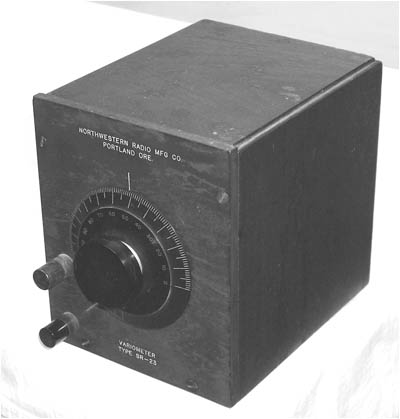
Figure 1. A Northwestern Radio Manufacturing Co. variometer, Type SR-23.Austin's Early Career in Radio
Charley Austin began his radio career as a thirteen year old when he read an article in a 1903 American Boy Magazine describing the construction of a receiver using a coherer as a detector and an induction coil as a transmitter. Five years later, Austin and four other young men of the local wireless club demonstrated radio at the Portland Public Library. The local paper, The Oregon Journal, reported messages transmitted and received, as well as the footsteps of a fly heard with the use of a sensitive microphone.
In 1911, Austin became the wireless operator abroad the S.S. Rose City. When home, he used the call C2, which derived from the fact the S.S. Rose City, was a station of the Continental Wireless Company of Tacoma, Washington. Since there were no federal regulations at the time to prohibit it, Austin communicated with many of the ships from his Amateur station in Portland.
During World War I, Austin enlisted in the United States Navy serving as chief electrician and radio inspector of the Portland Naval District for three and one half years where he helped build a Naval radio station in Northwest Portland. He also hired all the wireless operators and was in charge of all the Naval codes in the district.
Marketing Northwestern Radios
In the 1920s, Austin decided that the best way to sell Northwestern radios was to start broadcasting programs and create demand. He bought several stacks of phonograph records and began playing them, reaching the vessel Reuce 1,400 miles offshore on his station 7ZI.
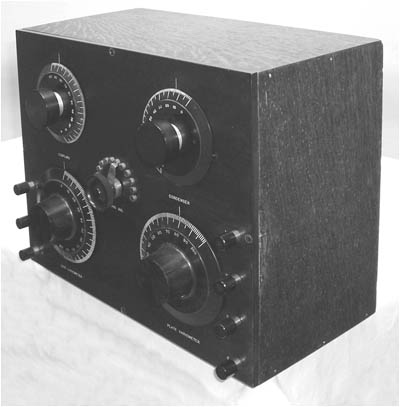
Figure 4. An oblique view of the Type SR-1 regenerative receiver, which is actually a tuner only. The SR-1 uses a Type SR-8 variocoupler and two Type SR-7 variometers.Hearing these musical broadcasts, the manager of a local record store made Austin a deal. All Austin had to do to receive a new stack of records was to announce, before the playing of each record, the name of the record and the phonograph it was played on, the price of the record, and the name and address of the Portland Remick Song Shop where the record was for sale.
Austin later started broadcasting at a regular schedule on 7XF becoming the second station in Oregon to do so. At the same time, he also designed the transmitter of station 7XG, rated in 1922 as the finest Amateur station west of Chicago and the first station in Oregon to broadcast on a regular schedule beginning on March 4, 1922.
Northwestern Products
The Northwestern Radio Manufacturing Company built and marketed a Variometer Type SR-7, a Variocoupler Type SR-8 with aluminum castings, Type SR-9 machined aluminum tube sockets, and Type SR-10 Bakelite knobs and dials. The knobs were turned from one-half Bakelite Dilecto Grade XX. The front panels were engraved on a Gorton Pantograph machine. Metal parts were nickel-plated brass in a satin finish, except for the cast aluminum brackets. The coils consisted of Bakelite Dilecto tubing and kiln dried hard maple. The grid and interstage capacitors were made of mica alternating with thin metal plates compressed between 1/8-inch thick Bakelite.
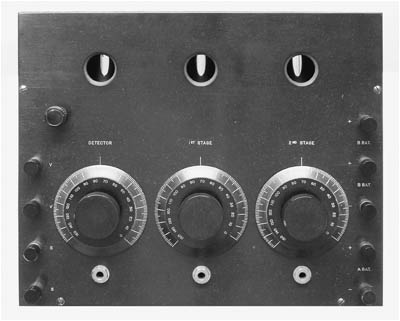
Figure 7. The Type SR-2 detector and 2-stage amplifier is housed in a cabinet 101/2" x 123/4" x 6". Peepholes are provided to view the tube filaments. Note the elaborate rheostat knobs.Figures 1, 2 and 3 (see print version) show a cabinet version of the SR-7 variometer, called the Type SR-23.
Northwestern manufactured two complete products, ca. 1921, utilizing the components they manufactured -- the Type SR-1, a shortwave regenerative receiver, and the Type SR-2, a detector and 2-stage amplifier. The cabinets were oak and had a waxed Flemish finish and 1/4-inch thick Bakelite front panels.
The Type SR-1 Short Wave Regenerative Receiver
Despite its name, "shortwave regenerative receiver," the 5-dial Type SR-1 is really a tuner that is used in combination with the Type SR-2 detector/amplifier. The Type SR-1 sold for $60, weighed 13 pounds, and had a wavelength range of 170 to 850 meters. The SR-1 is shown in Figures 4, 5 and 6 (see print version).
The primary circuit of the receiver consisted of a variable inductance in series with the antenna tuning capacitor. The switch controlling the tapped inductance was on the back of the panel. An antenna capacitor connected across the front binding posts in parallel with the primary coil allowed the listener to receive lower frequencies with a shorter antenna.
The secondary circuit is tuned by the SR-7 Variometer connected in series with the SR-8 Variocoupler. When shunted by a small fixed capacitor furnished with each receiver, the secondary circuit allowed reception of maritime stations on long wavelengths. Regeneration resulted by tuning the plate circuit with a second SR-7 variometer.
The Type SR-2 Detector/Amplifier
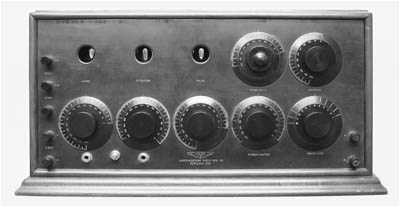
Figure 10. A front view of the Northwestern Model SR-21, a 3-tube regenerative receiver. Peepholes are provided to view the tube filament, and large calibrated knobs are used on the filament rheostats. Battery connections are on the left, and the antennas and ground binding posts are on the right side of the panel.The Type SR-2 detector and 2-stage amplifier, shown in Figures 7, 8 and 9 (see print version), sold for $70 weighed 10 pounds. Three SR-10 dials were used on the filament rheostats for the detector and two Type 201 audio amplifier tubes. The tubes plugged into SR-9 tube sockets mounted on a sub base of 1/8-inch thick Bakelite. The grid leak is adjustable and is made a part of the grid condenser.
The Types SR-1 and SR-2 units had the same outside dimensions 101/2" x 123/4". They were touted as "the combination of all combinations" when used together making the ideal receiver for the radio relay man or separately in conjunction with any receiver, either short or long wave.
After the company grew and moved to SE Division St., it discontinued manufacturing some individual components because it was more economical to purchase them from outside suppliers.
The Type SR-21 Regenerative Receiver
Shown in Figures 10, 11, 12, 13 and 14 (see print version), is the 7-dial, SR-21, ca. 1923. It is a 3-tube regenerative receiver, using three Type 01-A tubes as a detector and a 2-stage audio amplifier.
The Norco 77 TRF Receiver
Among the better known Norco products was the 1925 Norco 77, a 7-tube TRF shown in Figures 15, 16, 17 and 18 (see print version). It has four tuned stages, three RF amplifiers plus a detector, all using Type 01-A tubes. The audio circuit has two AF amplifiers, using Type 01-As, plus a Type 71-A for output. Voltage requirements are the following: A, 6 volts; B, 45, 90 and 135 volts; three C sources, one for RF and detector circuits, one for two audio amps, and one for the output stage.
Following Models SR-21, SR-25, and Nor-wes-co, the brand name became Norco and included receivers with a 2-stage triode regenerative detector, followed by the neutrodynes. Exporting their Norco Models D, Deluxe, and 55, to Japan and other countries became a sound business practice because the company received payment when the radios were on board ship.
The Depression and Beyond
Patent litigation was the main factor in the company's ceasing business in 1929. In all, the company sold over 100,000 sets. In 1930, the company became the Model Aircraft Works and Radio Apparatus after the city of Portland hired Austin to install the first police radio station in Oregon. The call letters were KGPP standing for Government Portland Police, which operated on 2.452 MHz.
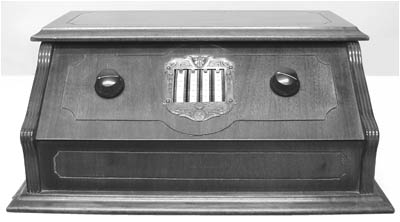
Figure 15. A front view of the 7-tube Model 77 radio. Tuning is accomplished by the four thumbwheel knobs.Next, the City of Portland hired Charley Austin to engineer the installation of a more powerful 500-watt police radio station in 1932, but he did not build it. Instead, the manufacturer was the Portland firm of Hallock and Watson. The station was located on the southwest slopes of Mount Tabor at Water Reservoir No. 5, and Austin became its chief radio engineer. He held that position with the police bureau for 25 years until retiring in 1955. He also taught Morse code classes at the YMCA.
After retirement, Austin constructed model train locomotives. His pride and joy is a perfect scale model of the Hudson type 4-6-4 oil fired locomotive used by the Union Pacific and Southern Pacific Railroads.
The boiler maintained 150 pounds of steam. Austin said, "I've got more than 3,000 hours of hard work in that baby."
An Oregonian newspaper reporter asked Charley in December 1968 if he had any radio stuff around the house. Except for a scrapbook comprising of catalog sheets, faded photographs and newspaper clippings, the seventy-eight year old Austin replied, "Heck, no. I have had enough of that for this life. All I want to do now is sit in an easy chair and watch the idiot box."
References:
"Advertising by Radio," Radio News, October 1921, pp. 281, 348.
"Amateur Radio Set Is Local Innovation," The Oregonian, March 20, 1921, Section 2, p. 2.
"Among Our Neighbors: Charley Austin," The Oregonian, September 25, 1938, Page 6.
Clutter, Sonny. Member Northwest Vintage Radio Society, owner, photographer of Northwestern Radio Manufacturing Company radios. E-mail: Radiolaguy.com
"Northwestern Radio Manufacturing Company Bulletins 1 and 2." Portland, Oregon, 1922.
"Retired Ham Doesn't Miss It a Bit," The Oregonian, August 22, 1968, Section 5, p. 1.
Sloat, F.W. "The Northwestern Radio Manufacturing Company," The Call Letter: Northwestern Vintage Radio Society, Volume 16, Number 11, November 1990, pp. 8, 9.
Photo credit: Sonny Clutter, "The RadiolaGuy," sonny@radiolguy.com.
(Art Redman, 7731 SE 44th Avenue, Portland, Oregon 97206)
Art Redman is a charter member of the Northwest Vintage Radio Society, which was founded in 1974. He is a frequent contributor to the Society's newsletter "The Call Letter." His current interest is doing research on Pacific Northwest radio manufacturers, including Long Radio Works, Northwest Radio Manufacturing, and Cole, McKay, and Magic crystal sets, as well as the firm of Hallock and Watson.
| [Free Sample] [Books, etc., For Sale] [Subscribe to A.R.C./Renew] [Classified Ads] [Auction Prices] [Event Calendar] [Links] [Home] [Issue Archives] [Book Reviews] [Subscription Information] [A.R.C. FAQ] URL = http://www.antiqueradio.com/Sep05_Redman_NRMC.html Copyright © 1996-2005 by John V. Terrey - For personal use only. Last revised: August 25, 2005. For Customer Assistance please contact ARC@antiqueradio.com or call (866) 371-0512 toll free Pages designed/maintained by Wayward Fluffy Publications
Antique Radio Classified |